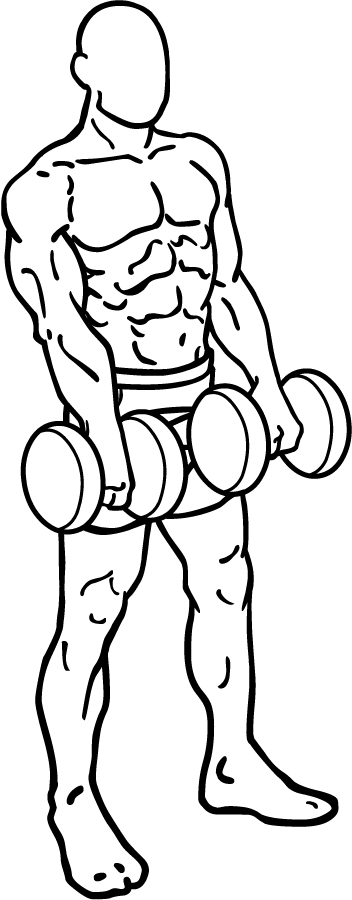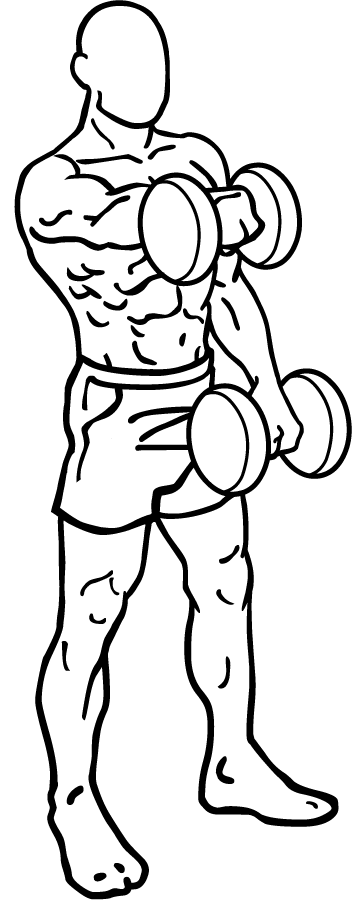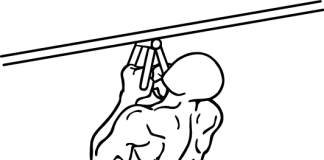Last Updated on October 16, 2014
Front dumbbell raises are one of the most effective exercises for building strong, well-defined shoulders. This movement primarily targets the anterior deltoid (the front part of the shoulder), helping to sculpt the shoulders and create a balanced, muscular upper body. It’s a simple yet highly effective exercise, making it suitable for both beginners and seasoned lifters. The unilateral (one-sided) nature of the movement ensures that both shoulders are trained evenly, preventing muscle imbalances and promoting symmetry.
In this detailed guide, we will explore everything you need to know about the front dumbbell raise, including its benefits, the correct technique, variations, common mistakes to avoid, and tips for making the most out of this powerful shoulder exercise. Whether your goal is to build strength, improve shoulder stability, or enhance your physique, the front dumbbell raise can help you achieve those goals.
Benefits of Front Dumbbell Raises
Before diving into the steps and form, it’s important to understand the benefits of front dumbbell raises and why you should incorporate them into your workout routine.
- Targeted Shoulder Strength: The front dumbbell raise isolates the anterior deltoids, which are responsible for lifting your arms in front of your body. Stronger anterior deltoids not only improve your shoulder strength but also contribute to better performance in other upper-body exercises like overhead presses and bench presses.
- Enhanced Shoulder Definition: This exercise helps build the front portion of your shoulders, giving your upper body a more defined and sculpted appearance. It’s particularly beneficial for creating the coveted “cap” on your shoulders that enhances overall aesthetics.
- Improved Posture: Strong shoulders are essential for maintaining good posture, especially if you spend long hours sitting or hunched over a computer. By strengthening the anterior deltoids, front dumbbell raises help keep your shoulders pulled back, reducing the risk of slouching and promoting a more upright posture.
- Increased Upper Body Stability: Front dumbbell raises require control and stability, which helps engage the stabilizing muscles in your shoulders and upper back. This improves overall upper body stability and reduces the risk of injury during other exercises or daily activities.
- Functional Strength: Beyond aesthetics, this exercise enhances functional strength that is useful for everyday tasks such as lifting, pushing, and carrying objects. Strong anterior deltoids can make these tasks easier and reduce the risk of injury.
- Symmetry and Balance: Because front dumbbell raises are typically performed one arm at a time, they allow you to focus on each shoulder individually. This helps correct any strength imbalances between the left and right shoulders, leading to better overall symmetry.
Muscles Worked in Front Dumbbell Raises
The front dumbbell raise is an isolation exercise that primarily targets the anterior deltoids, but it also engages several other muscles to a lesser extent. Here’s a breakdown of the muscles worked during this exercise:
- Anterior Deltoid: This is the main muscle targeted during the front dumbbell raise. The anterior deltoid is responsible for lifting the arm in front of the body and is crucial for shoulder strength and stability.
- Pectoral Muscles (Chest): Although the deltoids are the primary movers, the chest muscles (specifically the upper portion of the pectoralis major) are also engaged to assist with the lift.
- Trapezius: The trapezius muscles, located between your neck and shoulders, help stabilize the shoulder blades during the movement.
- Core Muscles: To maintain stability and prevent swaying or arching your back, your core muscles—particularly the abs and lower back—are engaged throughout the exercise.
- Forearms: Holding the dumbbells with an overhand grip also works the forearms, improving grip strength and endurance.
Step-by-Step Guide to Performing Front Dumbbell Raises
Now that you understand the benefits and muscles worked, let’s dive into the proper technique for performing front dumbbell raises. Proper form is essential not only for maximizing the effectiveness of the exercise but also for preventing injury.
1. Start with the Right Equipment
For this exercise, you will need two dumbbells of appropriate weight. If you’re new to front dumbbell raises, it’s best to start with lighter weights to focus on form and gradually increase the weight as you build strength. Choose dumbbells that allow you to complete the exercise with control and proper technique.
2. Set Up Your Stance
Stand up straight with your feet shoulder-width apart. This stance provides a stable base and allows you to maintain balance throughout the movement. Your knees should be slightly bent to reduce strain on your lower back and to engage your core.
Hold a dumbbell in each hand with an overhand grip (palms facing the floor). The dumbbells should hang down by your sides, and your arms should be fully extended but not locked at the elbows. Your core should be tight, and your back should remain straight throughout the exercise. Avoid arching your back or leaning forward, as this can lead to injury and reduce the effectiveness of the exercise.
3. Engage Your Core and Lift the Dumbbell
With your core engaged and your posture upright, begin the exercise by raising your left arm straight in front of you. Your arm should remain straight, but your elbow should not be locked. Lift the dumbbell in a controlled motion until your hand reaches just above shoulder height.
As you lift the weight, keep your palm facing down. This ensures that your anterior deltoid is doing the bulk of the work. Your wrist should remain neutral—don’t let it bend or curl during the movement.
4. Pause at the Top
Once your left arm reaches just above shoulder height, pause for a brief moment. This pause allows your muscles to fully engage and adds an extra layer of intensity to the exercise. Resist the urge to lift the dumbbell any higher, as this can place unnecessary strain on your shoulder joint.
During this pause, focus on maintaining a strong core and stable posture. Your body should remain still, with no swaying or leaning backward.
5. Lower the Dumbbell in a Controlled Motion
After the brief pause, slowly lower the dumbbell back to the starting position. The descent should be controlled and deliberate—avoid letting the weight drop quickly. Lowering the dumbbell with control ensures that your muscles remain engaged throughout the entire movement, particularly during the eccentric (lowering) phase, which is important for muscle growth.
Once the dumbbell is back in the starting position, your arm should be fully extended but not locked.
6. Repeat with the Right Arm
After completing the lift with your left arm, repeat the movement with your right arm. The same principles apply: raise the dumbbell in a controlled motion, pause at the top, and lower it back down slowly. Performing the exercise one arm at a time helps ensure balanced development between both shoulders.
7. Continue for the Desired Number of Reps
For a full workout, aim to complete 3 to 4 sets of 8 to 12 repetitions per arm, depending on your fitness level and goals. As you progress, you can increase the weight of the dumbbells or add more sets to challenge your muscles further.
Important Tips for Proper Form and Maximizing Results
To get the most out of front dumbbell raises, it’s crucial to focus on proper form and technique. Here are some tips to help you perform the exercise correctly and avoid common mistakes:
- Keep Your Core Engaged: Maintaining a tight core is essential for stabilizing your body and preventing unnecessary movement during the exercise. A strong core also helps protect your lower back from strain.
- Avoid Using Momentum: One of the most common mistakes with front dumbbell raises is using momentum to lift the weights. Swinging your arms or using your entire body to lift the dumbbells takes the focus off your shoulders and reduces the effectiveness of the exercise. Keep the movement slow and controlled to fully engage the target muscles.
- Don’t Lift Too High: Your hand should stop just above shoulder height. Lifting the dumbbell higher can place strain on your shoulder joint and engage muscles that aren’t meant to be targeted by this exercise. Focus on controlled lifts to shoulder height for the best results.
- Neutral Wrist Position: Keep your wrist in a neutral position throughout the movement. Bending or curling your wrist can lead to discomfort or injury and takes the focus off your shoulders.
- Choose the Right Weight: It’s important to start with a weight that allows you to maintain proper form. Using weights that are too heavy can lead to poor form, increasing the risk of injury. Start light, and gradually increase the weight as you build strength.
- Watch Your Posture: Keep your back straight, chest up, and shoulders pulled back throughout the exercise. Avoid leaning backward or arching your spine, as this can lead to lower back strain. Engaging your core will help you maintain good posture.
Common Mistakes to Avoid
As with any exercise, there are common mistakes that can reduce the effectiveness of front dumbbell raises or increase the risk of injury. Here are some pitfalls to avoid:
- Leaning Back: Leaning back or arching your spine to compensate for the weight of the dumbbells is a common mistake. This can place strain on your lower back and reduce the effectiveness of the exercise. Keep your core tight and maintain an upright posture.
- Using Too Much Weight: Lifting dumbbells that are too heavy can cause you to use improper form, such as swinging your arms or leaning back. Start with a lighter weight and focus on controlled movements. As you build strength, you can gradually increase the weight.
- Locking Your Elbows: Locking your elbows at the top of the lift can place unnecessary strain on your joints. Keep your arms straight but slightly bent at the elbows to protect your joints and ensure that your muscles are doing the work. This slight bend at the elbow helps maintain tension in your deltoids and minimizes the risk of injury.
- Rushing the Movement: Speeding through the reps, especially when lowering the dumbbells, is another common mistake. The lowering phase, or eccentric phase, is just as important as the lifting phase for muscle growth. Take your time with each rep, focusing on a slow and controlled movement to fully engage your muscles.
- Neglecting Core Engagement: Failing to engage your core can lead to poor posture and reduce the effectiveness of the exercise. A strong core helps stabilize your body and protects your lower back from strain. Keep your abs tight throughout the movement to maintain proper form.
Variations of the Front Dumbbell Raise
To keep your workout routine fresh and to challenge your muscles in different ways, you can incorporate variations of the front dumbbell raise. These variations target the same muscle groups but add new elements to the exercise, such as increased stability or greater range of motion.
1. Alternating Front Dumbbell Raise: This variation is similar to the standard front dumbbell raise, but instead of lifting one arm at a time, you alternate arms with each rep. For example, lift your left arm, lower it, and immediately lift your right arm. Alternating arms allows you to maintain constant tension in your shoulders and can also increase the intensity of the exercise.
2. Seated Front Dumbbell Raise: Performing front dumbbell raises in a seated position eliminates the ability to use momentum, making the exercise more challenging. Sit on a bench with your feet flat on the floor and your back straight. Raise the dumbbells as you would in the standing version, but focus on keeping your body completely still. This variation puts even more emphasis on the deltoids since your core and legs can’t help with stabilization.
3. Resistance Band Front Raise: If you don’t have access to dumbbells, you can use a resistance band to perform the same movement. Stand on the middle of the band with your feet shoulder-width apart and hold the handles in each hand. Perform the exercise in the same way, raising your arms to shoulder height while keeping the movement slow and controlled. Resistance bands provide constant tension, which can add a new dimension to the exercise.
4. Plate Front Raise: Instead of using dumbbells, you can use a weight plate to perform the front raise. Hold the plate with both hands in front of your thighs, and raise it to shoulder height. This variation engages your core and forearms more intensely, as you’ll need to stabilize the plate during the lift. It’s a great alternative if you want to mix things up in your shoulder routine.
5. Front Raise with Isometric Hold: For an added challenge, incorporate an isometric hold into the front dumbbell raise. When you lift the dumbbell to shoulder height, pause and hold the position for 5 to 10 seconds before lowering it back down. This increases time under tension and enhances muscle activation, making the exercise more intense and effective.
Progression and Adding Front Dumbbell Raises to Your Routine
As with any exercise, progression is key to continued muscle growth and strength gains. To make sure you’re consistently challenging your muscles, follow a progression plan for front dumbbell raises.
Weeks 1-2: Start with 3 sets of 8 to 10 reps using a light to moderate weight. Focus on perfecting your form and controlling the movement.
Weeks 3-4: Increase the weight slightly and aim for 3 sets of 10 to 12 reps. You can also add a brief pause at the top of the lift to engage your muscles more intensely.
Weeks 5-6: Increase the weight again and progress to 4 sets of 8 to 10 reps. You can also try incorporating one of the variations mentioned above to keep your routine challenging.
Weeks 7-8: Continue to increase the weight, focusing on 6 to 8 reps per set. You can also add an isometric hold at the top of the movement or try the seated front dumbbell raise for added intensity.
By gradually increasing the weight and incorporating variations, you can continue to challenge your muscles and avoid hitting a plateau.
Incorporating Front Dumbbell Raises into Your Workout Routine
Front dumbbell raises can be easily integrated into your existing workout routine. Here are a few ideas on how to include them in different types of workouts:
- Upper Body Day: Since front dumbbell raises primarily target the shoulders, they make a great addition to any upper-body workout. Pair them with other shoulder exercises like lateral raises and overhead presses to build a comprehensive shoulder routine.
- Push Day: If you follow a push-pull-leg (PPL) split, front dumbbell raises are perfect for your push day. This is when you focus on pushing movements like bench presses and shoulder presses. Add front dumbbell raises towards the end of your workout to isolate the anterior deltoids after completing heavier compound lifts.
- Shoulder-Specific Workout: If you want to dedicate an entire workout to building bigger and stronger shoulders, front dumbbell raises should be one of your go-to exercises. Combine them with other deltoid exercises such as lateral raises, bent-over reverse flyes, and overhead presses to target all parts of the shoulder.
- Circuit Training: Front dumbbell raises can be incorporated into a circuit training workout to keep your heart rate up while building strength. Pair them with other upper-body or core exercises, such as push-ups or planks, for a full-body workout that combines strength and cardio.
Preventing Shoulder Injuries and Maintaining Healthy Joints
While front dumbbell raises are a fantastic exercise for building shoulder strength, it’s important to take care of your joints to avoid injury. Here are some tips for keeping your shoulders healthy:
- Warm-Up Properly: Always warm up before starting your workout, especially when working your shoulders. Dynamic stretches like arm circles, shoulder rolls, and light resistance band exercises can help get your muscles and joints ready for the workout.
- Avoid Overtraining: The shoulder joint is one of the most complex and mobile joints in the body, but it’s also prone to injury if overworked. Make sure to give your shoulders enough time to recover between workouts, and avoid training them on consecutive days.
- Focus on Mobility: Regular shoulder mobility exercises, such as internal and external rotations with a resistance band, can help improve joint health and prevent injuries. Incorporating mobility work into your routine ensures that your shoulders remain strong, flexible, and resilient.
- Strengthen All Parts of the Shoulder: While the front deltoid is important, it’s equally important to strengthen the lateral and rear deltoids for balanced shoulder development. Incorporate exercises like lateral raises and bent-over reverse flyes to ensure all parts of your shoulders are evenly developed.
- Listen to Your Body: If you experience any shoulder pain or discomfort while performing front dumbbell raises, stop the exercise immediately. Shoulder injuries can be serious, and it’s important not to push through the pain. Consult a fitness professional or a medical expert if pain persists.
Front dumbbell raises are an excellent exercise for building strong, defined shoulders. By isolating the anterior deltoid, this movement helps create a balanced upper body, improves posture, and enhances functional strength. Whether you’re new to strength training or a seasoned lifter, incorporating front dumbbell raises into your routine can lead to significant shoulder improvements.
To get the most out of this exercise, focus on proper form, avoid common mistakes, and progress gradually by increasing the weight and incorporating variations. Remember to always prioritize shoulder health by warming up, incorporating mobility work, and listening to your body.
By making front dumbbell raises a regular part of your shoulder workout, you’ll be on your way to building stronger, more defined shoulders, improved posture, and increased overall upper body stability.


Exercise images by Everkinetic.






